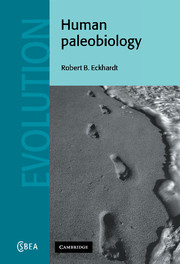Book contents
- Frontmatter
- Contents
- Preface
- Acknowledgments
- 1 Paleobiology: present perspectives on the past
- 2 Constancy and change: taxonomic uncertainty in a probabilistic world
- 3 A century of fossils
- 4 About a century of theory
- 5 Human adaptability present and past
- 6 Primate patterns of diversity and adaptation
- 7 Hominid phylogeny: morphological and molecular measures of diversity
- 8 Plio-Pleistocene hominids: the paleobiology of fragmented populations
- 9 Character state velocity in the emergence of more advanced hominids
- 10 The paleobiology of widely dispersed hominids
- 11 Paleobiological perspectives on modern human origins
- 12 A future for the past
- Bibliography
- Index
11 - Paleobiological perspectives on modern human origins
Published online by Cambridge University Press: 18 December 2009
- Frontmatter
- Contents
- Preface
- Acknowledgments
- 1 Paleobiology: present perspectives on the past
- 2 Constancy and change: taxonomic uncertainty in a probabilistic world
- 3 A century of fossils
- 4 About a century of theory
- 5 Human adaptability present and past
- 6 Primate patterns of diversity and adaptation
- 7 Hominid phylogeny: morphological and molecular measures of diversity
- 8 Plio-Pleistocene hominids: the paleobiology of fragmented populations
- 9 Character state velocity in the emergence of more advanced hominids
- 10 The paleobiology of widely dispersed hominids
- 11 Paleobiological perspectives on modern human origins
- 12 A future for the past
- Bibliography
- Index
Summary
Introduction
Following their spread from Africa to Eurasia a million or more years ago, hominids entered a prolonged phase of contact across these areas that allowed for the multidirectional transfer of two kinds of information – cultural and genetic. The cultural contact is documented, straightforwardly, by the association of human remains across the entire inhabited area with one or another manifestation of the Developed Oldowan/Acheulean tool complex. Tools of these related traditions are found at sites that arc from Kabwe in South Africa through Bodo in East Africa, westward through Europe at sites such as Arago in France and Steinheim in Germany, and eastward from Zuttiyeh in Israel through Narmada in India to numerous localities in China, including Dali and Maba. These continuities of material culture in themselves imply human contact and hence gene flow. This implication is supported further by the numerous broad phenotypic similarities among the human fossil remains discussed in greater detail below.
At the same time, other patterns delineate in situ adaptation to local and regional environments. There are contrasts in tool complexes between sites in the eastern and western ends of the Eurasian geographic continuum, of which just one major example is the lack of an Asian Acheulean (Pope & Keates, 1994; Schick, 1994). It is known that identifiable Levallois flakes and hand axes do occur at some Chinese sites, although infrequently (Pope, 1997).
- Type
- Chapter
- Information
- Human Paleobiology , pp. 257 - 279Publisher: Cambridge University PressPrint publication year: 2000



